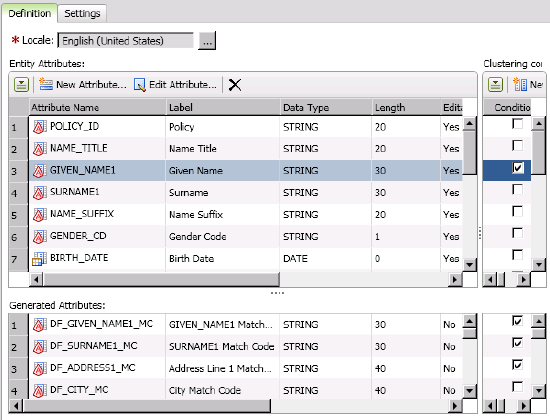Creating or Modifying Entity Definitions
You can create new entity definitions or modify existing definitions before you use them in master data projects. These entity definitions are used to process the source data that is loaded into the projects, and the entity attributes that you include in the projects affects the data that comes out of them. It is assumed that you have created a Master Data Projects repository.
Perform the following tasks to prepare your entity definitions:
- Create or Manage Entity Definitions
- Edit an Existing Entity Definition
- Use an Existing Entity Definition as a Template
Create or Manage Entity Definitions
You can create new entity definitions or manage existing definitions from the Folders riser. The following actions are available from the toolbar in the Entity Definitions pane. You can access this pane by clicking the Entity Definitions folder in the repository that you created for your master data projects:
- Action button - Displays a pop-up menu with options to Rename, Move to Folder, and Copy to Folder for the selected entity definition.
- New Entity Definition - Displays the New Entity Definition dialog, where you can create a new entity definition by supplying a name and save location. Note that when defining your own Entity Definition, you cannot use reserved field names such as DATE.
- Import and Export - Enables you to import or export an entity definition as a package file. For more information, see Exporting and Importing Metadata Packages.
- Open - Opens an existing entity definition for review or modification.
- Copy - Enables you to copy the selected entity definition.
- Delete- Deletes the selected entity definition.
- Lock and Unlock - Locks or unlocks the selected entity definition. While the definition is locked, only the locking user can modify it.
- Find in Folders - Locates the selected entity definition in the Folders riser.
Edit an Existing Entity Definition
You can open an entity definition to review QKB locales, add or edit attributes, modify clustering conditions, or review settings. Perform the following steps:
- Open an entity definition in the repository that contains your master data projects, such as the Person definition that is used in the MDM 2 Person master data project.
- Click Select a QKB Locale to review the list of locales. You can select a new locale, when needed. This selection only changes the list of definitions available to you when you create or edit a new attribute and choose to use a match definition or standardization definition.
- Click New Attribute, and specify a name, type, and length for the attribute. If you specify standardization or match code values, a generated attribute is created.
- Select an existing attribute, and click Edit Attribute. Modify the attribute as required, and click OK to save the changes.
- Select a Condition or Or Condition check box to add a clustering condition to an entity attribute or generated attribute.
- Click Settings to review the name, description, and notes for the entity definition.
Note that when you change you edit an existing entity definition, you must rebuild your master data foundation project. This edition process regenerates the jobs that are created to support your entity definition, replacing the previous locale specification in nodes that need it with the edited version.
Use an Existing Entity Definition as a Template
You can re-save an existing entity definition and use it as the template for a new definition. Perform the following steps:
- Open an entity definition, such as Person, which is shown in the following display:

- Click Save Entity Definition As in the File menu.
- Specify a name and a location for the new entity definition. For example, you could save Person_2 in the Definitions folder.
- Change the entity definition as needed. For example, you add entity attributes, delete attributes, set standardization and match code values, and specify clustering conditions. The Person_2 definition is shown in the following display:

Note that the GIVEN_NAME2 and SURNAME2 entity attributes have been deleted and a clustering condition added to the GIVEN_NAME1 attribute.
You can open an entity definition created in any version of DataFlux Data Management Studio. For example, you can open an entity definition created in a version of DataFlux Data Management Studio earlier than 2.3. However, if you modify that entity definition and save the changes, the saved definition cannot be opened in the earlier version of DataFlux Data Management Studio.
You can also open an entity definition created in SAS MDM in SAS Master Data Foundations in DataFlux Data Management Studio because SAS Master Data Foundations and SAS MDM share a common format for entity definition files. However, SAS MDM supports entity attributes and multiple entities that are not supported in SAS Master Data Foundations.
Therefore, you can open a SAS MDM entity definition that contains entity attributes in SAS Master Data Foundations, but they are ignored and not saved. Similarly, you SAS MDM can open a SAS MDM entity definition that contains multiple entities in SAS Master Data Foundations, but you must select only one entity to open and the only that entity is included when the file is saved. Note that you can use Save As to save the modified entity definition under a new name and leave the original entity definition intact, with its multiple entities and entity attributes preserved.